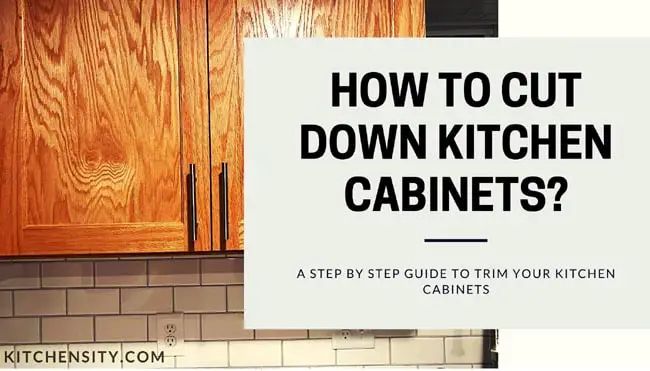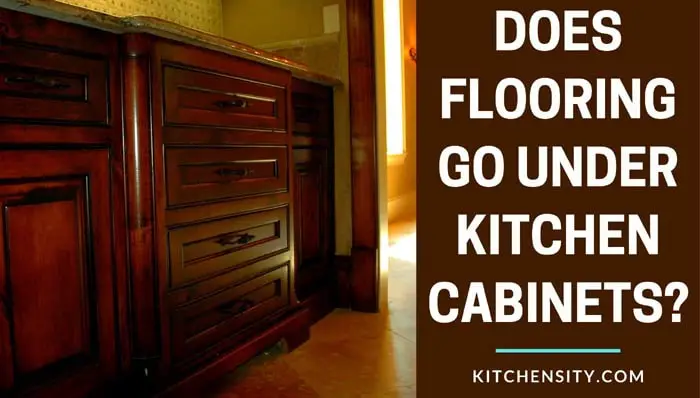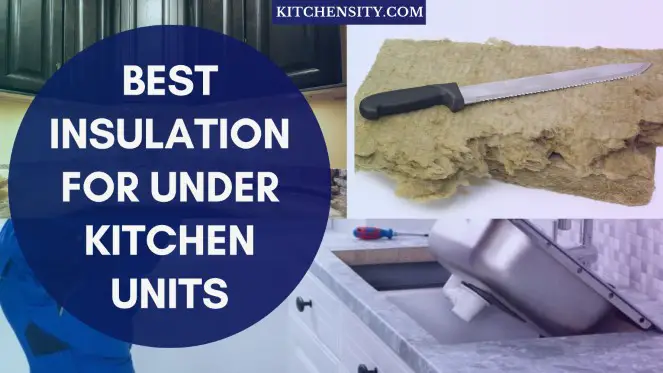Kitchens act as the heart of many homes, where memories and sustenance are crafted.
Are you tired of feeling cramped in your kitchen?
Do you dream of having more space to cook, store your essentials, and unleash your culinary creativity?
Well, we have an ingenious solution for you!
Say goodbye to cramped quarters and hello to a more spacious and efficient kitchen.
In this comprehensive guide, we’ll show you how to cut down kitchen cabinets and reclaim valuable real estate in your culinary haven.

Table of Contents
- 1 How To Cut Down Kitchen Cabinets?
- 2 Can Kitchen Cabinets Be Cut Down?
- 3 Steps to Resizing a Kitchen Cabinet
- 4 Steps to Resizing a Kitchen Cabinet Door
- 5 How To Cut Off The Bottom Of A Kitchen Cabinet Without Removing It?
- 6 How To Cut A Cabinet To Fit A Refrigerator?
- 7 Tips And Troubleshooting
- 8 Safety Precautions
- 9 Conclusion
- 10 You May Also Like
- 11 Frequently Asked Questions
How To Cut Down Kitchen Cabinets?
To cut down kitchen cabinets, follow these steps:
- Disassemble the cabinet by removing screws and hardware.
- Measure and mark the desired cutting line.
- Use a table saw to cut along the marked line.
- Detach the bottom piece and attach it to the cut-down cabinet.
- Shrink the stiles by removing screws and reattaching them.
- Reassemble the cabinet using glue, clamps, and nails.
- Resize cabinet doors by cutting them in half and reattaching them.
- Install hinges and hardware, then fill any saw marks.
Remember to prioritize safety by wearing protective gear and using proper tools. Cutting down kitchen cabinets can create more space and enhance your kitchen’s functionality.
Read below for a step-by-step guide.
Also Read – Do Kitchen Cabinets Need Crown Molding?
Can Kitchen Cabinets Be Cut Down?
Yes, you can cut down kitchen cabinets and you can do this by yourself. Keep reading as we cover how to shorten a kitchen cabinet so you can fit more in your kitchen.
But before starting the process, you have to arrange some tools (check the list below).
Materials Required
- Driver Driller or Screwdriver
- Any Saw (Preferred Table Saw)
- Nail Gun
- Sander
- Adhesive
- Rubber Mallet
- Straightedge
Also Read – Is Murphy Oil Soap Good For Kitchen Cabinets?
Steps to Resizing a Kitchen Cabinet
Cabinets in a kitchen are often overlooked when it comes to remodeling.
They may be painted over or not replaced as often as other aspects of the room, but they can play an essential role in your kitchen’s success.
If you’re thinking about updating your cabinets and want them resized, here are some steps to get started.
Step 1: Disassemble
Remove any screws that attach the door to the cabinet. Afterward, remove the hardware from the door.
Moreover, if the cabinet has any removable shelves, pull those out as well.
Step 2: Score The Cabinet (Measure)
Measure, then use a straight edge to draw a line around all four sides of the entire cabinet where you want to cut with your blade later on.
Next, line your cuts with masking tape—to prevent chipping—and draw a similar line over the tape.
Step 3: Remove the Face Frame
Remove the inside screws that secure the face frame to the cabinet. You can use a rubber mallet if you are having any trouble.
Also Read – How To Draft-Proof Your Under Kitchen Cabinets?
Step 4: Cut the Cabinet
- Get your table saw ready by setting its blade to 3/4 inches in height.
- Afterward, place the cabinet face up on the saw and align the saw and cabinet with the lines that you made in step two.
- Once you have your position set, lock the blade’s fence.
- Finally, cut along the lines and rotate the cabinet at quarter turns when you need to cut different sides.
- You should turn off the saw every time you rotate. Moreover, we recommend having an assistant help you position the cabinet.
- Use a hammer or rubber mallet to detach the bottom piece of the cabinet from its structure and use pliers to remove the pin nails.
- From there, align the detached bottom with the cut-down cabinet and fire four quarter-inch pin nails through the sides to attach the bottom to the cabinet.
- Then you will need to fire 3/4-inch stables into the back for additional security.
- While you are cutting, measure the width of the horizontal part of the face frame (around 1 1/4–1 1/2 inches) and cut.
Step 5: Shrink the Stiles
Remove the screws that secure the two stiles (vertical pieces) of the face frame and pull them out.
Also Read – How To Stop A Draught From Behind Kitchen Cupboards?
Step 6: Drill
Use a 3/16-inch bit and drill a couple of angled holes through the stiles near the inside bottom of the face frame. Afterward, apply glue to where you drilled.
Finally, use a 1 3/4-inch screw and reattach the horizontal rail to the stiles.
Step 7: Reassemble The Cabinet
Lay the cabinet face up along a couple of sawhorses and apply glue to the cut-off portions. Next, reattach the face frame and fire four 1 1/4-inch pin nails into each corner.
Afterward, apply clamps around each part of the cabinet and let the glue dry. Once the glue dries, remove them and reattach the shelves you took out earlier.
Also Read – Why Are My Kitchen Cupboards So Cold?
Steps to Resizing a Kitchen Cabinet Door
Do you have a kitchen cabinet door that is too big for the opening? Resizing a kitchen cabinet door can be done with some basic tools and patience.
Keep reading to learn how to complete the last several steps of cutting down your kitchen cabinets.
Step 1: Disassemble
Use your saw to divide the cabinet door in half. Afterward, strip the hardware from the door.
Step 2: Take Measurements
Measure how long your shortened cabinet is, subtract the difference between the cabinet and door lengths, and then set your saw to the resulting measurement.
Also Read – Best Insulation for Under Kitchen Units
Step 3: Cut
Carefully slide the bottom half of the door through the saw.
Step 4: Drill
Find the vertical sides of the top part of the cabinet door and drill two holes. Next, insert 1 3/4-inch screws into the new holes.
Also Read – How to Insulate Under Kitchen Cabinets?
Step 5: Reinstall
Spread glue to the bottom piece of the cabinet doors and reattach it.
Afterward, measure where the hardware was on your existing door and reinstall your resized doors to match.
Finally, attach the hinges to the doors and the cabinets. Moreover, use a putty crayon to fill any saw marks, but make sure it matches the color of your door.
How To Cut Off The Bottom Of A Kitchen Cabinet Without Removing It?
Cutting off the bottom of a kitchen cabinet without removing it can be a challenging task, but it is possible with the right approach.
Here’s a step-by-step guide on how to accomplish this:
Note: Before proceeding, ensure that you have taken proper safety precautions, including wearing protective eyewear and gloves.
- Measure And Mark: Start by measuring the desired height you want for the cabinet. Use a tape measure to determine the precise length that needs to be cut off. Mark this measurement on the vertical sides of the cabinet using a pencil or masking tape.
- Prepare The Cabinet: Clear out any items or shelves from the cabinet to create an unobstructed workspace. Ensure that the cabinet is stable and won’t tip over during the cutting process.
- Score The Cabinet: Using a straight edge, draw a straight line along the marked measurement on all sides of the cabinet. This line will act as a guide for the cutting process and help you achieve a clean and even cut.
- Cutting Technique: There are a few different techniques you can use to cut the bottom of the cabinet without removing it. Here are two common methods:
a. Oscillating Saw: If you have an oscillating saw, it can be an effective tool for this task. Insert a suitable wood-cutting blade into the saw, and carefully follow the marked line, making slow and steady cuts. The oscillating motion of the blade allows for precise and controlled cutting.
b. Circular Saw With A Guide: Another option is to use a circular saw with a guide or straight edge. Set the depth of the saw blade slightly deeper than the thickness of the cabinet material. Align the guide with the marked line and carefully cut it, ensuring that the saw remains in contact with the guide throughout.
Whichever method you choose, it’s important to cut slowly and steadily, allowing the blade to do the work without forcing it. Keep a firm grip on the saw and maintain control throughout the cutting process. - Smooth The Edges: After cutting, you may notice rough or uneven edges. Use a sander or sandpaper to smooth out any rough surfaces and create a finished look. Sand in a controlled motion, following the contour of the cabinet, until the edges are smooth and even.
- Clean Up: Once you have finished cutting and smoothing the edges, thoroughly clean the cabinet to remove any wood chips, dust, or debris. This will ensure a clean and tidy final result.
By following these steps, you can successfully cut off the bottom of a kitchen cabinet without the need for removal.
However, it’s important to approach this task with caution and precision to avoid any damage to the cabinet structure or surrounding areas.
If you are unsure or uncomfortable with the process, it’s advisable to consult a professional for assistance.
Also Read – Effective Ways To Update Old Kitchen Cabinets [Under $100]
How To Cut A Cabinet To Fit A Refrigerator?
Cutting a cabinet to fit a refrigerator requires careful planning and precise measurements.
Here’s a step-by-step guide to help you cut a cabinet to accommodate a refrigerator:
Note: Before proceeding, ensure that you have taken proper safety precautions, including wearing protective eyewear and gloves. It’s also recommended to work in a well-ventilated area or wear a mask to protect against dust.
- Measure The Refrigerator: Begin by measuring the dimensions of your refrigerator, including its width, depth, and height. Take accurate measurements of the widest and deepest points, as well as the height from the floor to the top of the refrigerator. These measurements will determine how much space needs to be created in the cabinet.
- Assess The Cabinet: Examine the cabinet above or beside the refrigerator and determine where you need to make adjustments to accommodate its dimensions. Identify the sections of the cabinet that need to be modified, such as the shelves, bottom panel, or doors.
- Empty The Cabinet: Clear out any items, shelves, or drawers from the cabinet to create an unobstructed workspace.
- Mark The Cabinet: Use a pencil or masking tape to mark the areas that need to be cut or modified. Mark the sections that need to be removed to create the necessary space for the refrigerator.
- Remove Shelves And Doors: If the cabinet has shelves or doors that interfere with the refrigerator’s dimensions, remove them. Unscrew any hinges or hardware that hold the shelves or doors in place and set them aside for reinstallation later.
- Cut The Cabinet: Depending on the specific modifications required, you may need different tools and techniques:
a. Circular Saw: If you need to trim the width or depth of the cabinet, a circular saw can be useful. Set the depth of the saw blade slightly deeper than the thickness of the cabinet material. Align the saw’s guide or straight edge with the marked lines and make slow, controlled cuts along the lines. Ensure that the saw remains in contact with the guide throughout the cuts.
b. Reciprocating Saw: A reciprocating saw or jigsaw can be used to make more intricate cuts, such as cutting out sections of the cabinet. Install a suitable blade for cutting wood and follow the marked lines, maintaining a steady and controlled motion.
Always follow the manufacturer’s instructions and exercise caution when using power tools. Take your time, and double-check measurements and markings before making any cuts. - Smooth And Finish: After making the necessary cuts, use a sander or sandpaper to smooth out any rough edges or surfaces. Sand in a controlled motion, following the contour of the cabinet, until the edges are smooth and even. If required, apply paint or finish to match the existing cabinet’s appearance.
- Reinstall Shelves And Doors: Once the modifications are complete and the cabinet is prepared to fit the refrigerator, reattach any shelves, doors, or hardware that was removed earlier. Ensure that they are securely fastened in their new positions.
- Test The Fit: Carefully slide the refrigerator into the modified cabinet, ensuring that it fits properly and there is adequate clearance for ventilation and door openings. Make any necessary adjustments if the fit is not optimal.
Remember, cutting a cabinet to fit a refrigerator is a precise task that requires accurate measurements and careful execution.
If you are unsure or uncomfortable with the process, it’s advisable to consult a professional for assistance.
They will have the necessary expertise and tools to ensure a successful modification that fits your refrigerator correctly.
Also Read – Can You Put Kitchen Cabinets On Top Of Vinyl Plank Flooring?
Tips And Troubleshooting
Here are some tips and troubleshooting suggestions:
- Double-Check Measurements: Accuracy is crucial when resizing kitchen cabinets. Measure multiple times before making any cuts to ensure precise dimensions. Use a measuring tape and a straight edge to maintain consistency throughout the process.
- Practice On Scrap Pieces: If you’re new to cutting cabinets, it’s a good idea to practice on scrap pieces of wood or old cabinets before working on your actual kitchen cabinets. This allows you to familiarize yourself with the tools and techniques and gain confidence before making any modifications to your cabinets.
- Secure Cabinets Firmly: When cutting the cabinets, ensure they are securely held in place to prevent movement and potential accidents. Use clamps or have an assistant support the cabinets during the cutting process.
- Use Proper Safety Equipment: Always prioritize safety during the resizing process. Wear safety goggles, gloves, and appropriate clothing to protect yourself from any potential hazards. If you’re using power tools, follow the manufacturer’s instructions and take the necessary precautions.
- Test Fit And Adjust: After making the necessary cuts, conduct test fittings to ensure the resized cabinets fit properly. Check the alignment, make any necessary adjustments, and retest until you’re satisfied with the fit.
- Address Surface Imperfections: If you encounter any chipping or rough edges during the cutting process, use sandpaper or a sander to smooth them out. This will give your cabinets a finished look and prevent any potential snags or splinters.
- Matching Hardware And Finishes: If you plan to reuse the existing hardware or add new hardware, ensure it matches the style and finish of your resized cabinets. This will create a cohesive and visually pleasing look in your kitchen.
- Seek Professional Help If Needed: While cutting down kitchen cabinets can be a DIY project, some situations may require professional assistance. If you feel unsure about certain steps, lack the necessary tools, or encounter unforeseen difficulties, it’s best to consult a professional to ensure a satisfactory outcome.
By incorporating these tips and troubleshooting suggestions, you can avoid common mistakes, and increase your confidence during the resizing process.
Also Read – How To Repair Chipped Paint On Kitchen Cabinets?
Safety Precautions
Safety should always be a top priority when undertaking any DIY project, including cutting down kitchen cabinets.
When working on cutting down kitchen cabinets, it is crucial to follow proper safety measures to protect yourself from potential injuries.
Here are some essential safety precautions to keep in mind:
- Protective Eyewear: Wear safety goggles or protective glasses to shield your eyes from flying debris, wood chips, and dust generated during cutting or sanding. This will prevent eye injuries and ensure clear vision while working.
- Gloves and Appropriate Clothing: Wear protective gloves to safeguard your hands from sharp edges, splinters, or accidental cuts. Additionally, wear suitable clothing that covers your arms and legs to minimize exposure to dust and potential injuries.
- Respiratory Protection: Depending on the materials used and the cutting method employed, it may be necessary to wear a dust mask or respirator to prevent inhaling harmful particles. This is particularly important when working with certain types of wood or when generating significant amounts of dust.
- Proper Handling of Power Tools: If power tools such as a table saw, drill, or nail gun are involved in the process, ensure that you are familiar with their safe operation. Read and follow the manufacturer’s instructions carefully, including guidelines on safety precautions and tool maintenance.
- Secure Work Area: Set up your work area in a clean, well-lit, and properly ventilated space. Remove any potential tripping hazards and ensure that the area is free from clutter. Keep bystanders, especially children, and pets, at a safe distance to avoid accidents.
- Tool Maintenance and Inspection: Before starting the project, inspect all tools and equipment to ensure they are in proper working condition. Check for any damaged cords, loose parts, or malfunctioning mechanisms. Never use defective tools, and if necessary, seek professional assistance or repair.
- Power Tool Safety: When using power tools, be cautious of the placement of your hands and fingers, keeping them clear of blades or moving parts. Use guards and safety features provided with the tools, and always disconnect the power source before making any adjustments or blade changes.
- Proper Electrical Handling: If electrical tools are involved, make sure to handle them with care. Ensure that all cords are in good condition, free from cuts or frays, and never operate tools with wet hands or in damp conditions. Use appropriate extension cords and avoid overloading electrical circuits.
- Fire Safety: Keep a fire extinguisher readily accessible in case of any accidental fires. Be mindful of flammable materials or substances in your work area and take precautions to prevent sparks or heat sources from causing a fire hazard.
- First Aid Preparedness: Have a basic first aid kit nearby in case of minor injuries. Familiarize yourself with the location and proper usage of the kit’s contents.
Also Read – Can You Use Loft Insulation Under Kitchen Cabinets?
Conclusion
In conclusion, learning how to cut down kitchen cabinets can be a valuable skill to maximize space and improve the functionality of your kitchen.
By following the steps outlined in this guide, you can successfully resize cabinets to fit a refrigerator or create more room for your cooking needs.
It’s important to approach this project with caution and adhere to safety precautions, such as wearing protective gear and using the right tools.
While cutting down cabinets can be a do-it-yourself project, it’s advisable to seek professional assistance for other aspects of your kitchen remodel.
By taking the time to carefully measure, cut, and reassemble your cabinets, you can achieve a more efficient and organized kitchen space.
With a little patience and the right tools, you can create a kitchen that not only meets your needs but also reflects your style.
You May Also Like
- What Can I Put Under My Kitchen Sink to Protect My Cabinets?
- Refacing Kitchen Cabinets: An Ultimate DIY Guide
- Chalk Paint Vs Latex Vs Regular Paint For Kitchen Cabinets
- How To Update Old Kitchen Cabinets?
- How To Repair Chipped Paint On Kitchen Cabinets?
- Why Are Kitchen Cabinets So Expensive?
- How To Fix Scratched Kitchen Cabinets?
Frequently Asked Questions
Do you want to resize your kitchen cabinets? With the right tools, knowledge, and skills, it’s possible! However, there are some questions that you should consider answering before starting this project.
Keep reading as we cover frequently asked questions by other home remodelers who are in similar situations as you.
-
What Saw Should I Use To Cut Cabinets?
To cut cabinets, you will want to use a table saw that has a finished blade. However, you can achieve similar results by installing a plywood blade within a circular saw.
-
How Do I Cut Kitchen Cabinets Without Chipping Them?
To cut kitchen cabinets without chipping them, you will need to invest in a special laminate blade for the jigsaw.
These blades are only cut one way so that on every stroke of the saw into the wood, chips will be minimized as they are pulled against gravity by pushing them down rather than just cutting through like typical metal-bladed tools would do.
A sharp blade is also necessary, making quick work out of any job with clean lines left behind! -
How Do You Cut the Bottom of Kitchen Cabinets?
You can cut the bottom of kitchen cabinets without removing them by taking the following steps:
1. Measure the bottom of your cabinet
2. Make a score
3. Take an oscillating saw and cut along the score—also divide the bottom of the cabinet into sections for the next step.
4. Use a tool like a screwdriver and pry out the bottoms. -
Can I Cut a Kitchen Cabinet in Half?
You can cut a kitchen cabinet in half by following the steps mentioned above but making a couple of tweaks.
Katrina Smith is a seasoned expert with over 25 years of experience in all things related to cooking and the kitchen. As an avid cook and kitchen enthusiast, she is passionate about sharing her knowledge and expertise on cookware, kitchen appliances, kitchen tips, and kitchen staples.
Through her articles and reviews, Katrina aims to inspire and help others improve their cooking skills, experiment with different ingredients, and invest in quality cookware and appliances.

![3 Effective Ways To Update Old Kitchen Cabinets [Under $100] 3 How To Update Old Kitche Cabinets](https://www.kitchensity.com/wp-content/uploads/2021/05/How-To-Update-Old-Kitche-Cabinets.jpg)
![Refacing Kitchen Cabinets: An Ultimate DIY Guide [2023] 4 Refacing Kitchen Cabinets](https://www.kitchensity.com/wp-content/uploads/2021/05/Refacing-Kitchen-Cabinets.jpg)



